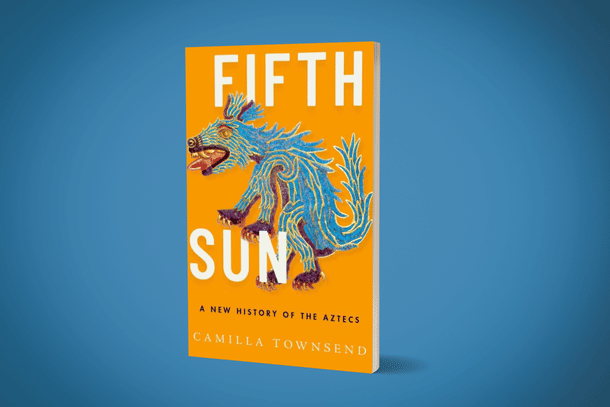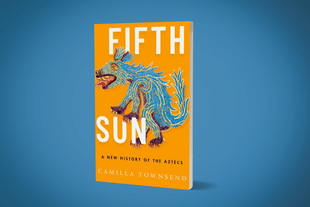Books
World Indigenous Peoples Day: This Book Debunks The Barbarous Reputation Of The Aztecs
Aravindan Neelakandan
Aug 09, 2021, 02:18 PM | Updated 07:02 PM IST
Save & read from anywhere!
Bookmark stories for easy access on any device or the Swarajya app.


Fifth Sun: A New History of the Aztecs. Camilla Townsend. Oxford University Press. Rs. 294 (Kindle). 320 Pages.
Whenever the name Aztec is mentioned for most educated persons around the world, the only image that comes to mind is the image of their lofty buildings and then the bloody sacrifices, where their priests cull out the hearts of living persons and offer it to the sun god so the sacrifice would make the sun go on doing its duty.
Another persisting myth is how the Aztecs thought the Aztec chieftain, Moctezuma, thought that Hernan Cortés, a conquistador for a god prophesied in Aztec religion, gave up without a fight.
In a detailed study of Aztec society using Aztec sources, historian Camilla Townsend, in her book Fifth Sun (Oxford University Press, 2019), provides an account that — decidedly more objectively and interestingly — comes closer to the way the Aztecs would have perceived themselves.
Townsend puts the first and most popular myth in its actual context. And the latter, she shows, to be probably a later fabrication.
Even the boastful Hernan Cortés did not make such a claim in his letters — that Aztecs accepted him as the returning god prophesied in their religion.
But what Townsend brings out regarding the origin of this ‘return prophesy’ myth is quite illuminating. It was not the Europeans who created it.
The children of the elite Aztecs, taken by the Franciscans — known for their religious fervour for schooling — created this myth in its original form as they grew up.
The students of the Franciscan friar Bernardino de Sahagún, author of the Florentine Codex, beginning in the 1560s and ’70s, wrote down what no indigenous person had ever said before — namely, that their forefathers had been paralyzed even before 1519 by the appearance of a variety of terrifying omens. Interestingly, the stories they told bore a distinct resemblance to the narrations in certain Greek and Latin texts that were in the Franciscan school library...
And with the right inputs, encouragements and libraries filled with European and Missionary literature, it was not long before we have the story of the invader greeted as the prophesied returning god:
Unfortunately, the students got the matter a bit confused. From their people’s own records, they knew of the arrivals along the coast in the two preceding years, and they said it was the second captain who was thought to be Quetzalcoatl returning from the east... But no matter. The gist of the story was there, and it could be taken up in generations to come and embellished as much as future authors saw fit to do. None of the original Nahua histories written down by the earliest generation of students in the privacy of their own homes had said anything like this. In fact, none of the elements ring true, given what we know about Mexica culture.
The colonial and evangelical frameworks often reinforced each other. The terrestrial aggression over the Aztecs, which brought definite economic prosperity to the plunderers, was justified and rid of guilt with the 'nobler' missions of 'civilising' their 'inhuman barbaric cultures' and 'saving their souls'.
Then, these justifications became history. In this book, Camilla Townsend penetrates these castles of deception and brings out the historical truth deeply imprisoned for the last four centuries.
The book is academic and facts-based — particularly the emphasis shifts from the way the Spanish and later the West described the conquest to the Nagual sources.
More importantly, the author does not bring in her own emotions, but allows the facts to speak.
Fifth Sun does not romanticise the pre-Spaniard Aztec life either. So before the Spaniards, the Aztecs had indeed built a stable empire with huge pyramids and flourishing art forms and safety offered to the citizens of their empire:
Yet, what made all this beauty and high culture possible was the Mexica rulers’ increasingly draconian measures, their tightening bureaucratic organization and control in various arenas of life, the ritualized violence they regularly enacted before audiences, and the warfare they did not fear to wage at the edges of their realm.
The author brings out gently, that whatever today we view as negative or inhumanly strange about Aztecs, could be told about every civilisation, even in a much worse way about the great powers of Western civilisation.
Ceremonial killings pervaded entire Europe. Inquisition burnings were religious executions. Mass executions were done in public.
While initially, their own people were sacrificed, and gods in their religion asked for sacrifices in gratitude, usually letting their own blood and only occasionally accepting human sacrifice, the Aztecs or Mexica, as they called themselves, grew in power and started sacrificing the prisoners of war.
Here is what Townsend writes about the Aztec human sacrifice:
Horrendous misconceptions have grown around the Aztec practice of human sacrifice. In novels, movies, and even some of the older history books, hundreds of people at a time were made to climb the narrow steps of the pyramids to the top, where their hearts were cut out and their bodies hurled downward, while the people screamed in near ecstasy below. In reality, it seems to have been a gravely quiet, spellbinding experience for the onlookers, much as we suspect it was in other old worlds, like that of the ancient Celts. The people who watched had fasted and stood holding sacred flowers. In the early decades of Tenochtitlan’s life, when the altepetl was still gathering strength, only a few people would have been sacrificed on the monthly religious festival days, and they were always treated as a holy of holies before they died. After a sacrifice, the warrior who had captured and presented the victim kept the remains (the hair and ceremonial regalia) in a special reed chest in a place of honor in his home for as long as he lived.Camilla Townsend, Fifth Sun : A new history of the Aztecs, Oxford University Press, 2019, pp.48-9
So, it was not a barbarous, wicked event where blood thirsty mobs and perverted priests killed for joy, but rather a solemn, sacred event.
Just for perspective, consider the following:
From the early Tudor period down to 1783, for instance, thousands of men, women and children were hanged at Tyburn outside London at six-week intervals. These hangings ought not to be sanitized as quick and easy. They were usually messy. Terrified victims typically kicked and bucked for five or more minutes on the end of the rope; the executioner often had to pull down on their legs and finish the job. There could be hemorrhaging, or the involuntary expulsion of excreta. The majority of victims were guilty of little more than theft. The crowds of spectators were so consistently large that the owner of a nearby farm built a wooden viewing gallery to cash in and entrepreneurs rented out carts and ladders to those seeking better view... Snacks were sold as the hangings progressed... Samuel Pepys nonchalantly includes notices of witnessing execution at Tyburn and elsewhere among his diary entries. On one occasion, he comments that he sent his wife to book a good sport for him, and even records that the display of one victim's heart and severed head to the crowd occasioned a shout of joy.Garrett Fagan, The Lure of the Arena Social Psychology and the Crowd at the Roman Games, Cambridge University Press, 2011, pp.61-3
Religious heretics suffered the most, depending on who ruled. Thus, in 1642, the severed head of a Catholic priest was used by the spectators to play football for six hours.
One cannot but imagine what would have been the narrative of history in a parallel universe where the Aztecs traded with England and France almost at the same time in our universe when the Spaniards conquered Aztec.
An Aztec observer would have been horrified by his own value system as we are today, when we learn about these inhuman aspects of European ‘civilisation.’
The entire book is an attempt to shatter the popular image that has been built in the minds of people about Aztecs. As pointed out earlier, Aztecs do not come out as living in a romantic, peaceful world before the Spaniards arrived.
Their world was filled with happiness and sorrow, pursuit of justice and tyranny of the powerful, sufferings of war and the prosperity of a centralised empire. They had a religion that had a sophisticated cosmology and also gods who demanded sacrifices in exchange of prosperity and victories.
In no way were they less human and less humane or more inhuman than any of the contemporary civilisations that lived in the world.
If anything, they lacked the blood thirsty mirth one finds in the mobs of England and France that cheered the executions.
Ultimately, the book also shows why it is important to hold on to the narratives about the people produced by those very people and preserve and nurture them in the forms they venerated.
If a story of a Spaniard conquest as the 'bloodless return of the prophesised god' could be made and it could be entered into history and that too by the very children of the families conquered and massacred by the very Spaniards, imagine what might be happening to the tribal communities conquered by the missionaries in our own Northeast and also how much of the colonial periods’ converted elite’s self-perception should be considered factual.
The book is in a way the retrieval of the truth through the memories held onto and recorded by the unconverted.





